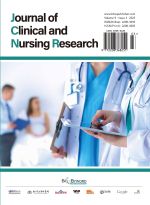Application and Research Progress of Moxibustion Therapy in the Care of Patients with Alzheimer’s Disease
Abstract
With the intensification of aging, the number of patients with Alzheimer’s disease (AD) in China has increased, which has brought a heavy burden to families and society. However, there is currently a lack of specific curative drugs for AD and commonly used clinical drugs can only relieve symptoms while accompanied by adverse reactions. Traditional Chinese medicine nursing techniques have unique advantages in the treatment of AD. Moxibustion therapy can improve cognitive function and improve living ability by stimulating acupoints with warmth. Therefore, this article summarizes the research progress of moxibustion therapy in the treatment of AD from the understanding of AD in traditional Chinese and Western medicine, an overview of moxibustion therapy, the mechanism of moxibustion therapy in the treatment of AD, and the clinical application of moxibustion therapy in the treatment of AD. It is hoped to provide a reference for the application of moxibustion therapy in AD patients.
References
Wang S, Fan X, Si Y, Zhou Z, 2024, Research on the Progress of Key Measurement Techniques for the Intrinsic Capacity of the Elderly in the Context of Healthy Aging. Chinese General Practice, 29(4): 1–10.
World Health Organization, 2017, Global Action Plan on the Public Health Response to Dementia 2017–2025. WHO Production Services, Geneva.
Alzheimer’s Disease Branch of China Geriatrics Health Care Association, Professional Committee of Brain Drug Research of China Association of Chinese Medicine, 2024, Chinese Expert Consensus on Integrated Chinese and Western Medicine Diagnosis and Treatment of Alzheimer’s Disease. Chinese Journal of Behavioral Medicine and Brain Science, 33(2): 97–108.
McKhann G, Knopman D, Chertkow H, et al., 2011, The Diagnosis of Dementia Due to Alzheimer’s Disease: Recommendations from the National Institute on Aging-Alzheimer’s Association Workgroups on Diagnostic Guidelines for Alzheimer’s Disease. Alzheimer’s Dementia, 7(3): 263–269.
National Center for Neurological Diseases, Xuanwu Hospital, Capital Medical University, Chronic Non-communicable Disease Prevention and Control Center, Chinese Center for Disease Control and Prevention, Capacity Building and Continuing Education Center, National Health Commission, et al., 2024, China Alzheimer’s Disease Blue Book (Condensed Version). Chinese Medical Journal, 104(29): 2701–2727.
Jia J, Wei C, Chen S, et al., 2018, The Cost of Alzheimer’s Disease in China and Re-estimation of Costs Worldwide. Alzheimer’s Dementia, 14(4): 483–491.
Khoury R, Rajamanickam J, Grossberg G, 2018, An Update on the Safety of Current Therapies for Alzheimer’s Disease: Focus on Rivastigmine. Therapeutic Advances in Drug Safety, 9(3): 171–178.
Guo T, Ren B, Liu Z, et al., 2020, Exploration of Moxibustion Therapy for Dementia. Journal of Clinical Acupuncture and Moxibustion, 36(2): 92–95.
Ashley S, Bradburn S, Murgatroyd C, 2019, A Meta-analysis of Peripheral Tocopherol Levels in Age-related Cognitive Decline and Alzheimer’s Disease. Nutrition Neuroscience, 24(10): 795–809.
Albert M, DeKosky S, Dickson D, et al., 2011, The Diagnosis of Mild Cognitive Impairment Due to Alzheimer’s Disease: Recommendations from the National Institute on Aging-Alzheimer’s Association Workgroups on Diagnostic Guidelines for Alzheimer’s Disease. Alzheimer’s & Dementia, 7(3): 270–279. https://doi.org/10.1016/j.jalz.2011.03.008.
Ma J, Xiao W, 2024, Early Diagnosis Methods of Alzheimer’s Disease. Chinese Clinical Research, 37(7): 1113–1119. DOI: 10.13429/j.cnki.cjcr.2024.07.026.
Expert Interpretation Writing Group for the Clinical Application of the Revised AD Diagnosis and Staging Criteria, Academic Committee of Beijing Cognitive Neuroscience Society, 2024, Expert Interpretation on the Clinical Application of the 2024 Revised Alzheimer’s Disease Diagnosis and Staging Criteria. Chinese Journal of Geriatrics, 43(12): 1525–1530.
Tian J, Shi J, 2018, Consensus on the Diagnosis and Treatment of Alzheimer’s Disease with Traditional Chinese Medicine. Chinese Journal of Integrated Traditional and Western Medicine, 38(5): 523–529.
Wang Y, Guo L, Dou Z, et al., 2011, Discussion on the Etiology and Pathogenesis of Senile Dementia from the Perspective of Traditional Chinese Medicine. Chinese Archives of Traditional Chinese Medicine, 29(4): 743–745.
Wei C, Tian J, Jia J, 2005, Understanding and Thinking about the Theory of Etiology and Pathogenesis of Senile Dementia in Traditional Chinese Medicine. Journal of Traditional Chinese Medicine, (8): 496–498.
Zhou Z, 2007, Internal Medicine of Traditional Chinese Medicine. 2nd ed. Beijing: China Traditional Chinese Medicine Publishing House, 2007: 157.
Wang Y, 2024, Progress of Chinese Medicine Research on Alzheimer’s Disease. Chinese Medicine, 13(6): 1267–1271.
Zhu C, Pan H, He S, 2015, An Analysis of the Academic Thought of Acupuncture and Moxibustion in the Treatment of Dementia by Dr Cai Shengzhao. Journal of Liaoning University of Traditional Chinese Medicine, 17(8): 110–112. DOI: 10.13194/j.issn.1673-842x.2015.08.036.
Li X, Wang J, Wu J, 2020, Data Mining Based Analysis of Clinical Point Selection Pattern of Acupuncture for Alzheimer’s Disease. Shanxi Traditional Chinese Medicine, 36(12): 48–52.
Cao J, Li Y, Li J, et al., 2016, Study on the Treatment of Alzheimer’s Disease and Its Mechanism by the Directing Vein. World Science and Technology-Modernisation of Traditional Chinese Medicine, 18(8): 1322–1326.
Shen F, Sun G, Du Y, et al., 2013, Discussion on the Treatment of Alzheimer’s Disease by Acupuncture and Moxibustion from the Theory of Benefiting the Kidney and Regulating the Governor. Journal of Hubei University of Traditional Chinese Medicine, 15(02): 44–46.
Jia J, Hou T, 2018, Progress in the Pathogenesis and Treatment of Alzheimer’s Disease. Chinese Medical Journal, 98(29): 2351–2356. DOI: 10.3760/cma.j.issn.0376-2491.2018.29.016.
Heneka M, Carson M, El Khoury J, et al., 2015, Neuroinflammation in Alzheimer’s Disease. Lancet Neurology, 14(4): 388–405.
Wang R, Liu J, 2021, Progress in Epidemiological Studies of Alzheimer’s Disease. China Chronic Disease Prevention and Control, 29(09): 707–711. DOI: 10.16386/j.cjpccd.issn.1004-6194.2021.09.016.
Yu J, Chu J, Gao L, et al., 2014, Effects of Wheat Grain Moxibustion on Learning Memory Ability and Amyloid Deposition in the Brain of Mice with Alzheimer’s Disease. Acupuncture Research, 39(01): 58–62 + 82.
Wang J, 2015, Study on the Effects of Moxibustion on Learning Memory, GSK-3B and Phosphorylated Tau Protein in AD Rats, thesis, Liaoning Medical College.
Ge H, 2022, Study on the Mechanism of Intervention of Alzheimer’s Disease by Regulating Plasma Exosome Expression by Moxibustion and Directing Pulse, thesis, Anhui University of Traditional Chinese Medicine.
Li C, Li X, Qiu X, et al., 2019, Role of Autophagy in the Pathogenesis of Alzheimer’s Disease. Chinese Journal of Cell Biology, 41(10): 2039–2046.
Zhu C, Zhang L, Song X, et al., 2019, Effects of Moxibustion on Autophagy Level and Learning Memory Ability in Transgenic Mice with Alzheimer’s Disease in the Duchenne Vein. Acupuncture Research, 44(04): 235–241. DOI: 10.13702/j.1000-0607.180305.
Wu Y, Song S, Zhu C, et al., 2022, Exploring the Effect of Moxibustion on Autophagy in Alzheimer’s Disease Mice Based on mTOR/p70S6K Signalling Pathway. Chinese Acupuncture, 42(09): 1011–1016. DOI: 10.13703/j.0255-2930.20210705-k0004.
Wang L, Zhu C, Wang L, et al., 2024, Effects of Moxibustion on AMPK/mTOR Signalling Pathway in the Hippocampus of Rats with Alzheimer’s Disease Based on the Theory of ‘Kidney-Brain-Phase-Assisted’. Journal of Anhui University of Traditional Chinese Medicine, 43(03): 42–47.
Wang Z, Zhou J, Shen Y, 2023, Progress of Research on the Mechanism of Action of Moxibustion on Alzheimer’s Disease. China Journal of Traditional Chinese Medicine Information, 30(03): 176–181. DOI: 10.19879/j.cnki.1005-5304.202203040.
Zhang M, Zhang S, Ma S, et al., 2021, Study on the Effect of Acupuncture on Alzheimer’s Disease and Microglia. Acupuncture and Moxibustion Clinical Journal, 37(11): 98–101. DOI: 10.19917/j.cnki.1005-0779.021233.
Huang Q, Li C, Zhang N, et al., 2022, The Effects of Moxibustion on Learning and Memory and m6A RNA Methylation in APP/PS1 Mice. Evidence-Based Complementary and Alternative Medicine, 2022: 2998301.
Li H, Shen Y, Xie L, et al., 2023, Moxibustion Affects Hippocampal Microglia Polarisation in Alzheimer’s Disease Mice via the Interleukin-33/Growth-Stimulated Expressed Gene 2 Protein Pathway. Acupuncture Research, 48(12): 1202–1208, 1235. DOI: 10.13702/j.1000-0607.20220877.
Zhang L, Zhang H, Sun B, 2017, The Role of Astrocytes in Alzheimer’s Disease and Its Molecular Mechanism. Life Science, 29(5): 501–506.
Tang S, Du Y, Tao Y, et al., 2019, Effects of Acupuncture on the Ultrastructure of Dentate Gyrus Neurons and Astrocytes in Rats with AB1-42 Induced Alzheimer’s Disease Model. Chinese Acupuncture and Moxibustion, 39(03): 281–286. DOI: 10.13703/j.0255-2930.2019.03.015.
Zhu C, Yang J, Fei A, et al., 2010, Observations on the Efficacy of Acupuncture and Moxibustion for the Treatment of Mild Cognitive Dysfunction in the Group of Acupoints of the Ducal Vein. Shanghai Journal of Acupuncture and Moxibustion, 29(11): 695–697.
Yang S, Fan D, Lin H, 2021, Effect of Pressure Moxibustion at Baihui Point on Clinical Efficacy and Serum Ca2+ in Patients with Alzheimer’s Disease. Shenzhen Journal of Integrative Chinese and Western Medicine, 31(13): 32–34. DOI: 10.16458/j.cnki.1007-0893.2021.13.015.
Shen W, 1996, A Preliminary Clinical Study of Acupuncture Treatment of Alzheimer’s Disease. Shanghai Journal of Acupuncture and Moxibustion, 1996(05): 6–7.
Su Q, He X, 2018, Observation on the Efficacy of Mild Moxibustion in the Treatment of Alzheimer’s Disease. Shanghai Journal of Acupuncture and Moxibustion, 37(06): 623–625. DOI: 10.13460/j.issn.1005-0957.2018.06.0623.
Yue R, 2021, Research on the Metabolic Function of AB Transporter in AD Model Rats by Thermal Moxibustion, thesis, Jiangxi University of Traditional Chinese Medicine. DOI: 10.27180/d.cnki.gjxzc.2021.000001.
Fu Y, Zhang H, Xiong J, et al., 2014, Clinical Study on the Treatment of Lumbar Intervertebral Disc Herniation by Thermal Moxibustion. Journal of Nanjing University of Traditional Chinese Medicine, 30(02): 120–123. DOI: 10.14148/j.issn.1672-0482.2014.02.006.
Wei L, Huang H, Wu X, et al., 2019, Observations on the Clinical Efficacy of Thunder Fire Moxibustion in the Treatment of Early-Stage Alzheimer’s Disease. Popular Science and Technology, 21(03): 46–48.
Wang H, Chen L, Yuan C, et al., 2019, Research Status and Prospect of Thunder Fire Moxibustion. Chinese Journal of Traditional Chinese Medicine, 34(09): 4204–4206.
Tang Y, Kang X, 2011, Clinical Study on the Treatment of Alzheimer’s Disease with Chinese Medicine and Moxibustion. Journal of Chinese Medicine, 26(06): 763–764. DOI: 10.16368/j.issn.1674-8999.2011.06.038.
Zhu Y, 2014, Observations on the Efficacy of Warm Acupuncture in the Treatment of Alzheimer’s Disease. Shanghai Journal of Acupuncture and Moxibustion, 33(11): 996–997. DOI: 10.13460/j.issn.1005-0957.2014.11.0996.
Su H, 2019, Clinical Observation of Acupuncture Plus Moxibustion of Dorsal Yu Points in the Treatment of Senile Dementia, thesis, Heilongjiang University of Traditional Chinese Medicine. DOI:10.27127/d.cnki.ghlzu.2019.000409.
He J, Liu Y, Shi Y, et al., 2023, Research Progress on Non-Drug Therapy Based on the Relationship Between the Internal Olfactory Cortex and Alzheimer's Disease. Chinese Journal of Traditional Chinese Medicine, 38(10): 4847–4850.
Zhang F, 2016, Observations on Daily Life Ability and Cognitive Function of Patients with Alzheimer’s Disease by Traditional Chinese Medicine Nursing. Shanxi Traditional Chinese Medicine, 32(09): 59–60.


